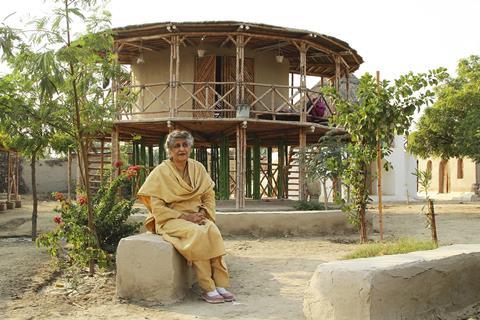Indujah Srikaran describes Sumita Singha’s new book as one that she wishes she’d had during her own education

A bright yellow cover, bold pink text, and the classic image of the Sri Lankan architect Minette De Silva, climbing a ladder in her saree, encases Thrive: A Field Guide for Women in Architecture by Sumita Singha. The cover screams “We are here, and we are proud”. It confirms to people like myself, an architect with Sri Lankan heritage, that female architects of colour are just as worthy of being on the front cover of an RIBA book!
Thrive follows five years from Singha’s Women in Architecture publication and discusses global issues on gender within architectural education and the profession today. As per the cover, the book proudly showcases global past and present female intersectional identities, encouraging female architects to embrace their experiences and stay authentic to themselves. The book is filled with many inspirational and relatatable moments throughout.
Looking at what Singha describes as “the three i’s” she writes about women in architecture through the lens of inclusion, internationalism and intersectionality. The latter included as its own final chapter to the book. Although the author states that the book does not need to be read in any particular order, the book is split into six chapters in total: Context, Education, Practice, Projects, Promotion and Intersectionality.
Prior to each chapter the book includes a quote from a current female architect, occasionally attaching their social media – promoting women within the book. The pages are visual, with many confident images platforming the work of successful women architects. The text is written in an extremely accessible way, allowing anyone from a young person interested in studying architecture, to someone who has been practicing for many years, to read it with ease.
In addition, at the end of each chapter there is a “key takeaway” section, where the reader can find the chapter’s main overarching arguments. Much of the book is data supported, delivering an evidenced based approach whilst emphasising the seriousness of the barriers at hand. Nevertheless there are a few limitations to the book which the author herself recognises. This includes the lack of data collected or analysed from many individual countries or international organisations on women in architecture, with much of the existing data being out of date.
Overall the book unmasks the names of global heroines that have often been erased and left uncredited for their significant contribution to the profession. It successfully showcases how gender associated behaviours are social constructs and reveals how women have always been involved in roles stereotypically labelled as “masculine”. Thrive teaches awareness of discrimination, prepares women entering education or practice of what is to come, and validates existing experiences.
It advises women to be vigilant of discriminatory behaviour and brings comfort in hearing you are not alone. The book also guides women on how they can promote themselves, illuminating the “tiara syndrome” and creating a dialogue about the successes of a “squiggly” career.
Singha offers many solutions and resources throughout, presenting inspiring quotes and case studies to exemplify how women have flourished across the globe, despite their sexist environments, through unconventional models e.g. women-led practices, collectives and collaborative working. Furthermore, Thrive argues that “equality is the goal while equity is the pathway”, hopeful that one day a woman can simply be considered an “architect” rather than a “female architect” or “a female architect of colour”.
It is a book that I wish I’d had during my education, and which I am glad I do have at the start of my professional career as an architect
A woman’s place within the built environment has constantly been questioned by the traditional “boys club” that is the architectural profession. This book begins to widen the architectural narrative, to open our eyes to the “women on whose shoulders we stand” and the amount of them there are! In the author’s words, “there is so much work by historical women architects to be uncovered…This book is only an introduction!”
The hope is that this book will be read by everyone in the profession and used by educators/writers/professionals to begin providing a greater, well-deserved space for these female architects to be applauded as individuals rather than getting lost in an exhaustive list.
The author is a remarkable female role model in her own right – Sumita Singha herself has pushed boundaries and has now created a space in history for women globally to be recognised, understood, honoured and celebrated.
Over 160 women globally (historic and present) have been selected and mentioned in the book, including their struggles and achievements, allowing it to avoid the typical Eurocentric narrative of women in architecture. Many of these women are unfortunately not known widely despite their talent, but this book shows women that they belong in the space and to persevere.
This book is for anyone who is committed to creating an equitable profession, who wants to understand their conditions, prepare themselves, and wants to find role models and ways to thrive. It is a book that I wish I’d had during my education, and which I am glad I do have at the start of my professional career as an architect.
>> Also read: Let’s celebrate the South Asian pioneers who blazed a trail for women in architecture
Postscript
Thrive: A Field Guide for Women in Architecture, by Sumita Singha, is published by RIBA Publishing
Indujah Srikaran is an architect at Sheldon Bosley Knight and a writer























No comments yet